 Business establishments owe patrons the duty of ordinary and reasonable care with respect to their safety. See Economy Cash & Carry Cleaners, Inc. v. Gitlin, 1 So.2d 191 (Fla. 1941), and our blog, Status Determines Duty in Florida Premises Liability Cases. To meet this duty with regard to chairs made available to patrons, the establishment must select bullet-proof, industrial grade chairs able to withstand heavy use by heavy people, or have an effective inspection and maintenance procedure in place. See, Fontana v. Wilson World Maingate Condominium, 717 So.2d 199 (Fla. 5th DCA 1998) (The court decided that the jury could have found that the owner’s ostrich like approach to the safety of its premises did not meet its obligations to its invitees.)
Business establishments owe patrons the duty of ordinary and reasonable care with respect to their safety. See Economy Cash & Carry Cleaners, Inc. v. Gitlin, 1 So.2d 191 (Fla. 1941), and our blog, Status Determines Duty in Florida Premises Liability Cases. To meet this duty with regard to chairs made available to patrons, the establishment must select bullet-proof, industrial grade chairs able to withstand heavy use by heavy people, or have an effective inspection and maintenance procedure in place. See, Fontana v. Wilson World Maingate Condominium, 717 So.2d 199 (Fla. 5th DCA 1998) (The court decided that the jury could have found that the owner’s ostrich like approach to the safety of its premises did not meet its obligations to its invitees.)
Continue reading
Articles Posted in Premises Liability
Florida Personal Injury Litigation: Avoid Being Tricked by Defendants — Obtain Accident Videotape Footage
While personal injury litigation in Florida courts is not supposed to be a game of “gotcha,” or trial by ambush, Surf Drugs, Inc. v. Vermette, 236 So.108, 111 Fla.1970,” unless attorneys pay careful attention, it can happen in their cases. One of the ripest areas for this gamesmanship to occur is in the use of accident videotape.
Premise liability defendants often have videotape of the accident. Rarely is it produced presuit, even when doing so might head off a lawsuit. Proof that tried and true policies aren’t always the best. Even during suit, defendants resist turning over the tape. In the hope of catching Plaintiffs giving testimony inconsistent with the events captured on tape, even if the inconsistencies are based on a lack of clear memory or a lack of knowledge, rather than untruthfulness, they want to question plaintiffs before producing the accident footage.
Continue reading
Key Issue in Florida Premises Liability Law — Obtaining Video Surveillance (or Getting a Spoilation Jury Instruction)
 Most business establishments today maintain some form of video surveillance to capture events, including accidents and assaults, that happen in and around their property.
Most business establishments today maintain some form of video surveillance to capture events, including accidents and assaults, that happen in and around their property.
The key to resolving premises liability claims fairly to all concerned — the injured person and the property owner — is by determining fully what happened.
Frequently, the information has been captured by the videotape camera(s).
Since the videotape is always in the hands of the target defendant, shouldn’t it always be made available to the plaintiff? The answer is, It depends.
In Osmulski v. Oldsmar Fine Wine, Inc., So.3d , 37 FLW D1578 (Fla. 2nd DCA 6-20-2012), the appellate court ruled that the defendant was not obligated to preserve the videotape of the accident without a request from the plaintiff. It ruled this way even though the defendant knew immediately of the accident and it was reasonably foreseeable the plaintiff would bring a claim to be compensated for her serious wrist injury (which required two surgeries and needed at least one more). By the time the request was made, after pre-suit negotiations had failed, the videotape had been deleted.
Continue reading
Proving Negligence in Florida Against Banks for ATM Crime-Related Injuries/Death
 By failing to comply with statutory (and regulatory) (deJesus v. Seaboard Coast Line Railroad, 281 So.2d 198 (Fla.1973)), industry (Seaboard Coast Line R. Co. v. Clark, 491 So.2d 1196 (Fla. 4th DCA 1986), and company safety standards (Steinberg v. Lomenick, 531 So.2d 199 (Fla. 3d DCA 1988), rev. denied, 539 So.2d 476 (Fla.1988) and Mayo v. Publix Super Markets, Inc., 686 So.2d 801 (Fla. 4th DCA 1997)), financial institutions can be held accountable in civil damages to those whose injuries and death — decedent’s survivors are compensated — were proximately caused by crimes associated with the use of ATMs and night cash depositories.
By failing to comply with statutory (and regulatory) (deJesus v. Seaboard Coast Line Railroad, 281 So.2d 198 (Fla.1973)), industry (Seaboard Coast Line R. Co. v. Clark, 491 So.2d 1196 (Fla. 4th DCA 1986), and company safety standards (Steinberg v. Lomenick, 531 So.2d 199 (Fla. 3d DCA 1988), rev. denied, 539 So.2d 476 (Fla.1988) and Mayo v. Publix Super Markets, Inc., 686 So.2d 801 (Fla. 4th DCA 1997)), financial institutions can be held accountable in civil damages to those whose injuries and death — decedent’s survivors are compensated — were proximately caused by crimes associated with the use of ATMs and night cash depositories.
Statutes & Regulations
Florida Statutes 655.960-655.965 contain some safety standards, but are limited in impact by 655.961, which provides: “A violation of the provisions of ss. 655.960-655.965 or any regulation made pursuant thereto does not constitute negligence per se.” Electronic Funds Transfer Act (Regulation E) and the Bank Protection Act (Regulation P) (12 CFR Section 216.1) are federal laws dealing primarily with matters related to the security of the ATMs themselves and to fraudulent transactions, rather than to ATM users’ safety.
Industry Standards
- Adequate lighting at and around ATMs. The typical minimum standards, including some mandated by law, are 10 foot-candles within five feet of the ATM, and two foot-candles 50 to 60 feet away from the ATM, measured at three feet above ground (Ellis 1996; CUNA Service Group 1999; Illinois Office of Banks and Real Estate 1999). Because these standards can leave gaps in coverage due to factors such as shadows, light-source direction, a qualified lighting designer should plan ATM lighting.
- Landscape and design for good visibility. Use slow growing shrubbery and plants and trim often. Objects that obstruct views, such as dumpsters, should be removed. Hidden alcoves should not be used.
- Install mirrors on ATM and in surrounding areas.
- Install ATMs where there is natural surveillance. In places with a lot of routine vehicle and foot traffic. Experts recommend visibility from three sides.
- Install ATMs in police stations.
- Relocate, close or limit hours of operation in high risk locations.
Comparative Fault and Open & Obvious Doctrines in Florida Premises Liability Accidents
 Comparative Fault — see Florida Statute 768.81 –and the Open & Obvious Doctrine are legal concepts that play a role in many premises liability cases.
Comparative Fault — see Florida Statute 768.81 –and the Open & Obvious Doctrine are legal concepts that play a role in many premises liability cases.
Under the principle of Comparative Fault, the jury is asked to apportion fault among the parties to a lawsuit, plaintiff and defendant(s), and others who may not even be parties to the lawsuit. The jury must also place a monetary value on the damage sustained by the plaintiff. These two findings make up what is known as the [jury’s] verdict. Interestingly, a jury verdict is not the same thing as a final judgment, issued by judges, and the final numbers between the two can be significantly different.
Here is a rudimentary example to demonstrate the interplay between verdicts and judgments, and illustrate the principal of comparative fault: Mr. Jones, while visiting a friend’s condominium complex, trips on a large crack in a poorly lit underground parking lot while walking into the building. He falls hard to the ground, landing on his chin and head, sustaining a severe laceration and a concussion. Fire Rescue is summoned and transports Mr. Jones to the hospital. The underground lot is owned by a condominium association that has hired a management company to maintain the premises. It is learned that the large crack has existed for years and has caused other accidents. Unable to settle out of court, Mr. Jones sues the condo association and the management company for negligence. The jury returns a verdict in the amount of $500,000, but apportions fault at 75% (condo. association/management company)/25% (Mr. Jones). Based on the concept of comparative fault, the final judgment for Mr. Jones will be $375,000, or 75% of the total damages found by the jury. (In most cases, the judge has much more to consider than simply performing basic math in reaching a final judgment.)
Until 1973, Florida applied the law of contributory fault in all negligence cases. Under this concept, the plaintiff would be completely barred from making any recovery if it was determined that he or she was at fault in any way, even only 1% at fault. In our example, this would mean that Mr. Jones, although only 25% at fault, would receive nothing for his injuries.
Continue reading
Violent Crime and Florida ATM Premises Liablity Law
 Due to flawed record keeping, it is impossible to know with confidence how often violent crimes — murder, kidnapping, battery or robbery — are committed in Florida in conjunction with obtaining cash involuntarily from a victim’s ATM. Most law enforcement agencies do not maintain a separate category for ATM crime. Instead, it is listed in more general categories such as robbery, homicide, and sexual battery/rape. The Universal Crime Report (UCR) forms do not have a place to note that a forced ATM withdrawal has taken place.
Due to flawed record keeping, it is impossible to know with confidence how often violent crimes — murder, kidnapping, battery or robbery — are committed in Florida in conjunction with obtaining cash involuntarily from a victim’s ATM. Most law enforcement agencies do not maintain a separate category for ATM crime. Instead, it is listed in more general categories such as robbery, homicide, and sexual battery/rape. The Universal Crime Report (UCR) forms do not have a place to note that a forced ATM withdrawal has taken place.
Despite the lack of information, ATM-related crime is believed to be high. Put another way, ATM-related crime is foreseeable.
The foreseeability of a harmful event happening is an essential element of every personal injury case. For a defendant to be held accountable under civil tort law, the victim, or Plaintiff, must prevent evidence on the issue of foreseeability.
Crime statistics are a way of proving foreseeability in civil tort actions for injuries or death resulting from inadequate security or safety measures. See Holley v. Mt. Zion Terrace Apartments, Inc., 382 So. 2d 98 – Fla: Dist. Court of Appeals, 3rd Dist. 1980.
Continue reading
Status Determines Duty in Florida Premises Liability Cases
 The initial question in every premises liability personal injury case concerns the concept of duty. What degree of duty did the landowner (or possessor) owe to the person injured to prevent the accident? Because the next inquiry concerns whether the duty was breached, the answer to the initial question often determines the outcome of these cases. Where no duty is breached, no fault lies. Sometimes the answer to the initial inquiry is clear, sometimes it is not. Due to its importance, duty is frequently litigated although not as much as the issue of breach.
The initial question in every premises liability personal injury case concerns the concept of duty. What degree of duty did the landowner (or possessor) owe to the person injured to prevent the accident? Because the next inquiry concerns whether the duty was breached, the answer to the initial question often determines the outcome of these cases. Where no duty is breached, no fault lies. Sometimes the answer to the initial inquiry is clear, sometimes it is not. Due to its importance, duty is frequently litigated although not as much as the issue of breach.
The extent of the duty depends on the person’s status on the property at the time of the accident. The following outline sets forth the various status categories recognized under Florida law and the duty owed under each.
- Public Invitee. A person who is invited to enter or remain on land as a member of the public for a purpose for which the land is held open to the public. (Example: Family in a public park.) This landowner has the following duties: (1) to correct or warn of dangers that the owner knows or should know of by the use of reasonable care, and which the visitor cannot or should not know of by the use of reasonable care; and (2) to maintain the premises in a reasonably safe condition. (For a fuller understanding of subsection (2), search our blog using the term “Open and Obvious.” Landowners like to claim that because a condition is open and obvious, there is no duty to repair it. This is sometimes correct, but not always.)
- Business Invitee. A person who is invited to enter or remain on land for a purpose directly or indirectly connected with business dealings with the possessor of the land. (Examples: A grocery story patron; a paying fan at a Miami Dolphins football game.) Duty: same as for Public Invitee.
- Licensee By Invitation. A social guest. Duty: same as for Public Invitee.
- Uninvited Licensee. A person who chooses to come upon the premises solely for his or her own convenience without invitation either expressed or reasonably implied under the circumstances. (Example: teenagers using a private parking as an ad hoc party location.) Duty: To refrain from willful or wanton injury (e.g., to remove any concealed “traps” of which the owner has actual knowledge).
- Trespasser. A person who enters the premises without license, invitation, or other right, and intrudes for some definite purpose of his own, or at his own convenience, or merely as an idler with no apparent purpose, other than perhaps to satisfy his curiosity. Duty: same as for Uninvited Licensee.
Potholes and Florida Personal Injury Law
 Must a landowner warn a visitor to the property of an open and obvious pothole? Probably not. Does a landowner have a duty to repair the pothole? Probably.
Must a landowner warn a visitor to the property of an open and obvious pothole? Probably not. Does a landowner have a duty to repair the pothole? Probably.
In Burton v. MDC PGA Plaza Corp., 78 So.3d 732 (Fla. 4th DCA 2012), the plaintiff was seriously injured when, while loading a vehicle, she stepped into a pothole, tripped, and fell to the ground. The pothole was approximately one foot wide and two inches deep. The plaintiff conceded that she knew about the pothole before she fell.
Because the plaintiff knew about the pothole before she fell, the court ruled that the plaintiff could not maintain an action against the landowner Defendant MDC or its tenant, CVS. Summary judgment was granted for the defendants.
Continue reading
Relevance of Prior Similar Accidents in Florida Premises Liability Cases
 Success for the victim of a premises liability accident requires that he or she prove the defendant knew or should have known beforehand of the existence of the dangerous condition which caused the accident, and that the accident was foreseeable.
Success for the victim of a premises liability accident requires that he or she prove the defendant knew or should have known beforehand of the existence of the dangerous condition which caused the accident, and that the accident was foreseeable.
One of the most effective ways of establishing these elements is through similar prior accidents.
Most business establishments prepare incident reports following accidents. The reports contain accident details along with the victim’s name and contact information.
Once a lawsuit is filed, the Florida Rules of Civil Procedure allow the parties to obtain case relevant information, also known as discovery, from each other and non-parties. Subpoenas, depositions, and document requests are the common methods of obtaining information.
Typically, the prior incident reports themselves are not discoverable based on the privilege doctrine of being prepared in anticipation of litigation. However, defendants must provide detailed information about prior accidents, including victim names and contact information, date and location of incidents, and some description of what occurred. Publix Supermarkets, Inc. v. Martin, 739 So.2d 174 (Fla. 2d DCA 1999).
Continue reading
Florida Premises Liability Standards for Accidents Causing Personal Injuries
 Under Florida law, the duty owed by landowners and/or those in control of properties to individuals other than employees – injuries to employees are governed by Florida’s workers’ compensation system (see Chapter 440 of the Florida’s Statutes) – depends in part on the individual’s purpose for being on the property.
Under Florida law, the duty owed by landowners and/or those in control of properties to individuals other than employees – injuries to employees are governed by Florida’s workers’ compensation system (see Chapter 440 of the Florida’s Statutes) – depends in part on the individual’s purpose for being on the property.
Florida divides the status of individuals on property into five categories. This blog lists the categories and the duties owed under each category.
Continue reading
 Florida Injury Attorney Blawg
Florida Injury Attorney Blawg

